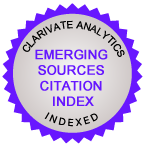Revisiting the narrative structure of the short story “Nika” by V. Pelevin
DOI:
https://doi.org/10.21638/spbu09.2018.302Abstract
The article is dedicated to the narrative structure of the short story “Nika” by V. Pelevin. An evident feature of the story is a game relationship with a potential reader. In the process of reading anyone would believe that the heroine is a girl, but the last sentence reveals that she isthe cat belonging to the main character. The main feature of the narrative structure is a “gap” between the character, the narrator and the implied author (this gap is not so obvious because of the first-person narration). The unnamed character unsuccessfully tries to understand the inner world of his cat, because he wants to meet another vision of reality. The narrator wants to take a look at the world in new ways too, but he realizes that his vision is limited by the traditions of the Russian literature. So, the narrator tries to go beyond his own vision by having a thought experiment. The narrator is the one who creates a text like a riddle: he is hinting the correct answer to the potential reader, and at the same time, he is confusing him/her, playing with the natural rules of speech construction. The character, the narrator and the author faced a communication barrier, but the author doesn’t try to overcome it. On the contrary, the author recognizes the equality of different points of view on the world, understands the inevitability of such a barrier. The didactic author is cheating the real reader, to teach him some of his own calm attitudes to the world, but to achieve this goal he creates this gap between the narrative instances.
Keywords:
V. Pelevin, postmodernism, game with the reader, narrative structure, narrative strategy
Downloads
References
References
Downloads
Published
How to Cite
Issue
Section
License
Articles of "Vestnik of Saint Petersburg University. Language and Literature" are open access distributed under the terms of the License Agreement with Saint Petersburg State University, which permits to the authors unrestricted distribution and self-archiving free of charge.






